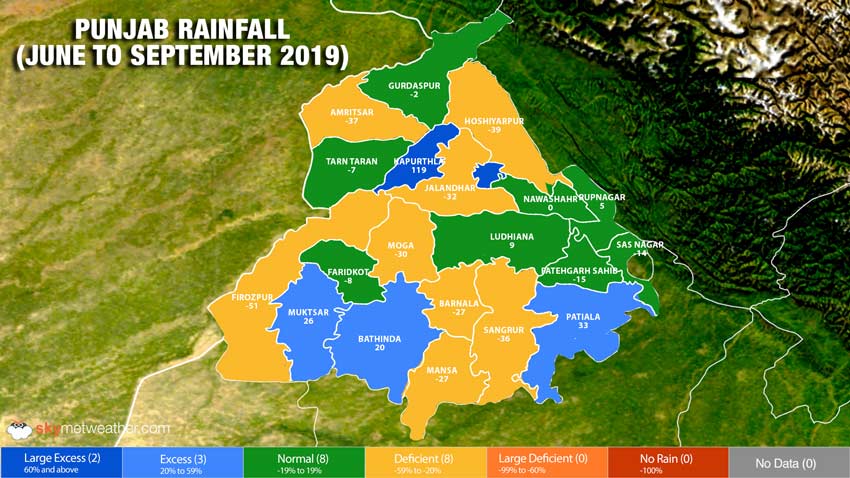
Punjab and Haryana are the two-intensive agrarian regions of our country. While Punjab is one of the most fertile regions on Earth. The region is ideal for growing wheat, rice, sugarcane, fruits and vegetables. Indian Punjab is called the “Granary of India” or India’s breadbasket.
Punjab experiences both summer and winter to its extreme. It even receives abundant rainfall, which makes the state a very fertile land. The region lying near the foothills of Himalayas receives heavy rainfall whereas the region lying at a distance from the hills, the rainfall is scanty, and the temperature is high.
The Monsoon rain this year has been on a lesser note in both these regions. While talking about the Pan India scale, the rainiest week experienced was from September 19 to September 25, 2019 wherein many pockets of our country got flooded and pan India it was rain surplus by 37%. Despite such good rains, Punjab during this week was deficit by 66% and thus the season deficiency remains in double digits at 11% until September 27.
Punjab state is divided into three major regions Majha, Malwa and Doaba. This division of Punjab is basically due to the rivers Sutlej (or Satluj) and Beas flowing through the land of Punjab. All these three pockets this year have had a mixed response even though they are co-located. Malwa is large in size and Doaba in comparison to these two is the smallest. Majha is close to the foothills and comprises of Pathankot, Gurdaspur, Amritsar and Tarn Taran districts. The Majha region mainly covers the area between Beas and Ravi rivers. The area on the north of Sutlej, after the confluence of Beas and Sutlej at Harike in Tarn Taran district, extending up to the Ravi river is also part of the Majha region. Pathankot, Gurdaspur which is close to the foothills performed better in comparison to Tarn Taran which didn’t do well in this season till date.
While Doaba is the area between the rivers Satluj and Beas. Doaba comprises of Jalandhar, Hoshiarpur, Kapurthala and Nawanshahr. Two of its districts have performed very well wherein Kapurthala is excess by 119% and Nawanshahr is just normal. While the other two that are Jalandhar and Hoshiarpur are deficit by 32% and 39%, respectively.
Malwa comprises of the mixed arid region, fertile areas and areas which are close to the foothills. The region of Punjab towards the left bank of Sutlej river is called Malwa. Malwa comprises of Bathinda, Fatehgarh Sahib, Faridkot, Fazilka, Firozpur, Ludhiana, Mansa, Moga, Mohali, Muktsar, Patiala, Ropar, Sangrur. In this, Patiala which is in the East Malwa performed the best and is rain surplus by 33%. Whereas Firozpur and Mogha in the West of Malwa didn’t perform well and are deficit by 51% and 30%, respectively. Also, Muktsar and Bathinda are surplus by 26% and 20%, respectively with Fazlika falling under the deficit zone.
The centre of Malwa comprises of Barnala, Sangrur and Mansa are almost deficit by 30% while Ludhiana has performed a shade better and is surplus by nine percent.
While Mohali, Ropar, Patiala, Fatehgarh Sahib falls under the eastern part of Malwa. They all are within normal and out of this Patiala has done fairly good.
The figures clearly tell us that Punjab is persistently witnessing deficit Monsoon season just barring the last year wherein it was surplus by seven percent.
In 2017 Punjab was rain deficit by 21%, 2016 was deficit by 25%, in 2015 it was lagging by 31% while in 2014 it was highly deficit by 50%.
The principal crops of Punjab are barley, wheat, rice, maize and sugarcane. Among the fodder crops are Bajra and Jowar. The main sources of irrigation are canals and tube wells. The economy of the state primarily depends upon the agriculture sector. The state has been tackling drought-like conditions courtesy good water management systems.
Till date Punjab is deficit by 11% and in the remaining days of September we will see some rainfall, but it will not suffice to cover the deficiency. We can expect light to moderate rains over the northern districts and tomorrow the rain activity will be widespread in nature. It is expected that Gurdaspur, Pathankot, Hoshiarpur may see moderate showers during the next 24 hours.
Image Credits – Skymet Weather
Any information taken from here should be credited to Skymet Weather


